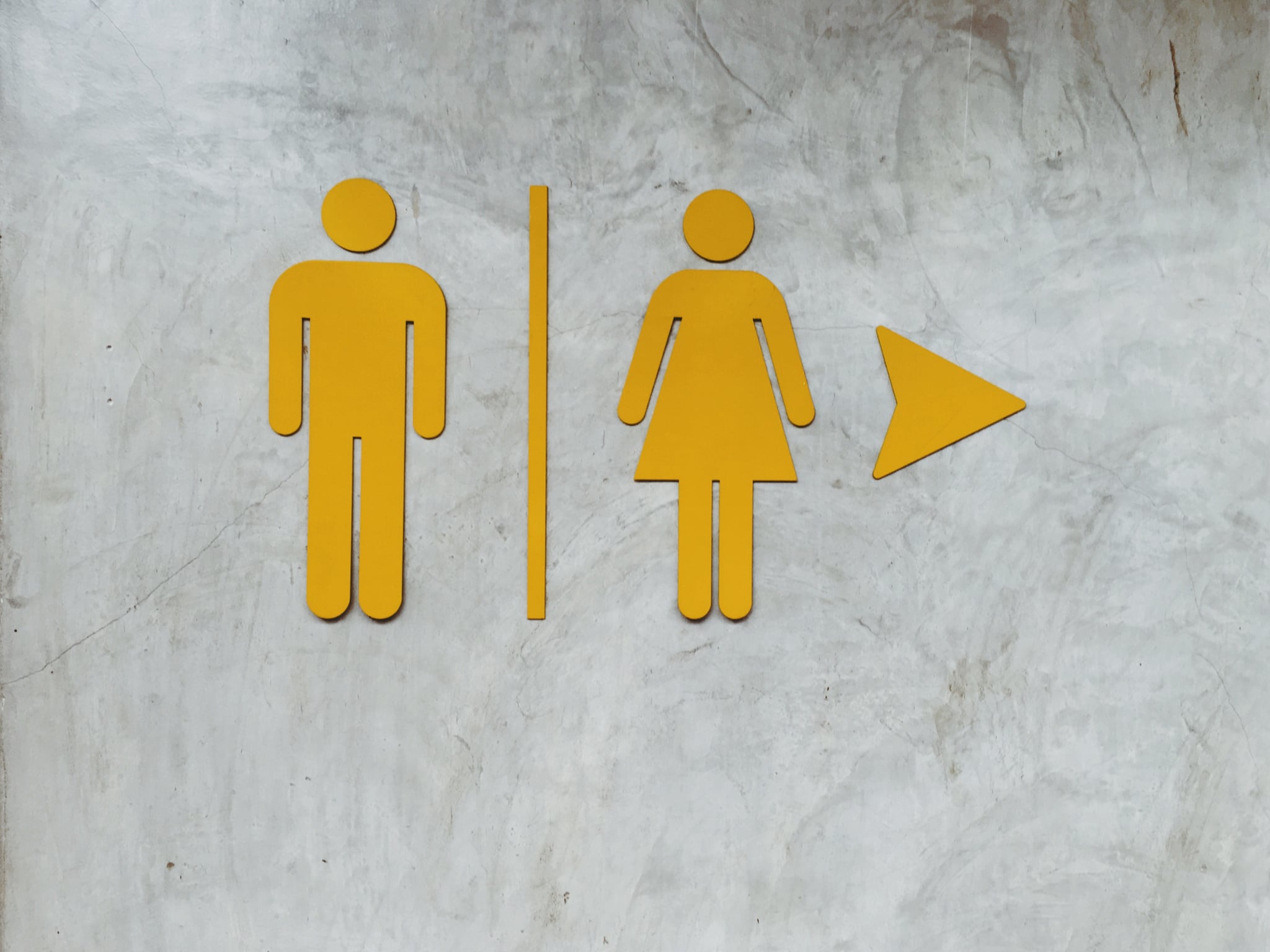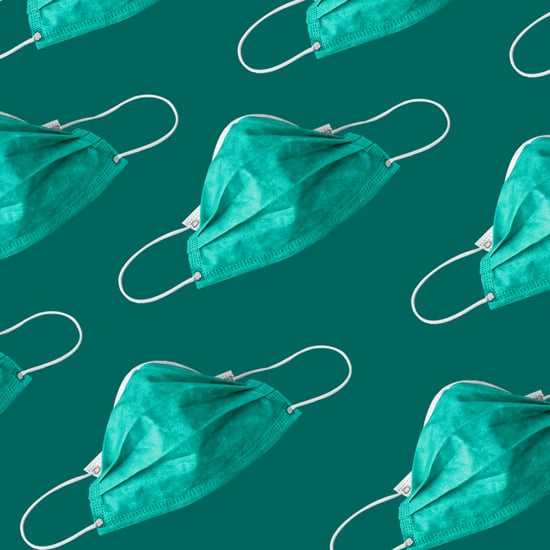Is It Safe to Use a Public Restroom During COVID-19?

We're months into the COVID-19 outbreak in the US and more than halfway through 2020, and while some states have begun to ease restrictions, others are reversing or stopping their reopening efforts due to a spike in cases across the country. When we spoke to medical experts about how to safely be in public spaces (if you have to), the primary takeaway was to proceed with caution. "Nothing is 100 percent safe in this day and age, especially in a shared, public space," said Sandra Kesh, MD, deputy medical director and infectious diseases specialist at Westmed Medical Group in Westchester, NY.
It's important to remember there's still so much unknown about COVID-19 and information is constantly changing about contagion, so it can be tough to say what is and not safe. So what does that mean in terms of public restrooms — spaces that aren't particularly sanitary even in the healthiest of circumstances? We talked to experts to find out.
Is It Safe to Use a Public Restroom Amid COVID-19?
According to Will Kimbrough, MD, senior medical director at One Medical, it depends. "The risk factors for COVID-19 [within this context and otherwise] are based on whether or not someone you're near is infected and contagious, how close you are to them and for how long, whether or not you're wearing a mask and washing your hands, and how the air is moved and filtered in the space," he said. "Public bathrooms can represent everything from very high risk to very low risk based on these inputs. A well sanitized, well ventilated and rarely used toilet in an area where there's not a lot of COVID-19 spreading would be very low risk to use."
Dr. Kesh agreed. "A lot depends on how many people are using the bathroom, how often it is cleaned, and how the layout is spaced out," she told POPSUGAR. "A lot also depends on the bathroom itself and what the facility has done to safeguard people."
Consider the layout and the space. "Rest stops, for instance, have always been very crowded even before the pandemic," said Dr. Kesh. "You need to take basic steps to minimize the risk in public washrooms but I would say they will always be considered relatively high risk, and you make may want to avoid them if you can." And, of course, always wear a mask when going into a public restroom.
Can COVID-19 Be Transmitted Through Urine or Feces?
Ah, the age old question of "Can I get COVID through someone's pee?" — a tale that is not as old as time, though certainly on many minds, particularly when deliberating on use of a public bathroom in 2020.
"You can find [COVID-19] in both urine and feces," said Dr. Kesh. Dr. Kimbrough confirmed this as well (so did the CDC), sharing that "there have been some studies showing COVID-19 virus in feces," but "there haven't been any known cases of transmitting COVID by feces contamination."
Dr. Kesh also said that the transmission of COVID-19 through excrement is not certain, nor confirmed. "What we currently don't know is whether there is enough virus present in stool or urine to transmit [COVID-19]."
Are Public Bathrooms More Dangerous Than Other Indoor Areas?
While the scientific jury is still out on whether or not traces of COVID-19 can be spread through pee or poo in a public restroom (gross all around), what remains true (as of now) is that COVID-19 can be transmitted through surface contact, and you have have to touch a lot of stuff in a bathroom.
The NIH found that "SARS-CoV-2 remained active on plastic and stainless steel surfaces for two to three days under the conditions in this experiment. It remained infectious for up to 24 hours on cardboard and four hours on copper."
So . . . Can I Touch the Toilet Seat?
To squat or not to squat! That is the question. The doctors seemed relatively unpeeved by this perspective, but of course went the 'rather safe than sorry' route. "Contact with a toilet seat is actually pretty safe, but if it makes you feel more comfortable, it's always okay to take the more cautious approach," said Dr. Kimbrough.
Dr. Kesh thinks hovering is a good idea, but to be mindful of mess-making. "I think it's a good idea to hover, but the only thing is it can create a mess for others," she said. "Be sure to wipe the seat if you decide to hover. Another good option is to use a toilet seat cover or put toilet paper on the seat before you use the toilet."
But Aren't COVID-19 Particles Airborn?
So among the lovely phrases that have been added to the cultural vernacular in 2020 — murder hornets, cannibal rats, etc. — we now have "toilet plume" joining the party. The idea is that flushing propels microscopic bacteria and particles (aerosols) into the air — yikes!
The experts said this isn't just media buzz; it's real. "Gross, right? Unfortunately, this is a known thing even before COVID-19," said Dr. Kimbrough. "Whether this could actually contribute to the spread of COVID infection from one person to another is unknown."
"Fluid in the toilet can create a plume when flushing which aerosolizes some of the water and subsequent bacteria in the toilet," said Dr. Kesh."Because of the potentially infectious particle in the plume, close the toilet seat before you flush, if possible. When you are done using the toilet, get out of stall as quickly as you can."
Essentially be ready to book it once you are flushing. "Flushing should be the last thing you do before you hightail it out of the bathroom stall, especially if there is not toilet seat cover. Another thing to keep in mind is how business owners keep the air clean in bathroom. There should be exhaust fans for proper circulation, and every bathroom should have their air filters changed regularly."
What's the Best Way to Sanitize After Using a Public Restroom?
Head for the sink, if one is available. Dr. Kesh suggests soap and water saying "it's better almost across the board." "Hand sanitizer is a good substitute if soap is not available. Then, when you get to a place with soap, I recommend washing your hands with soap and water again."
Dr. Kimbrough reminded us to wash or sanitize for at least 20 seconds. "This should effectively kill the virus from your hands, so do whichever makes the most sense based on the layout of the bathroom," he said. "For example, if you can't get a clean paper towel without touching a shared surface or there isn't ample soap available, opt for the hand sanitizer."
As for drying those freshly washed hands, there have been questions as to how sanitary air-dryers are, especially in a time during a pandemic in which a respiratory virus is spread through the air. For now, the docs recommend using paper towels.
"The route of transmission for the coronavirus is through droplets and possibly aerosol," said Dr. Kesh. "You don't need to be worried about getting infected through your skin, but what should concern you is your skin being a vehicle for transmission and then the air dryer blowing those particles into your respiratory tract. Also, the hand dryer has the potential to disperse bacteria all around the bathroom so opt for paper towels where possible."
"It would be unlikely that air hand dryers would contain enough of the virus in them to contaminate your hands, but using paper towels would be preferred to avoid re-touching a surface (if there is a button to press on the dryer) that others have also touched," said Dr. Kimbrough. He noted a bonus that comes with use of paper towels: "These can also be used to turn on and off taps and open the door to leave to reduce risk of contamination of your hands after washing them."
Drying your hands is a super crucial step, though. "The main goal of drying your hands is to ensure that all moisture is removed from the hands," said Dr. Kesh. "Viruses do not survive well on dry surfaces, whereas moisture helps viruses survive and thrive. Whatever you use to dry your hands, for example, if there is no paper towel available and you need to use an air dryer, you should be sure to remove all moisture."
TL;DR: soap, water, paper towels (when possible) are going to be the winning combo.
How Much Time Can I Safely Spend in a Public Restroom?
As little time as possible is going to be your goal. In, don't touch anything, take care of business, wash your hands, out. "Based on the best studies of how long it takes to be around COVID-19 to become infected, I would suggest staying in a contaminated space under 10 minutes is best," said Dr. Kimbrough. "But shorter is better!" And, again, you should be wearing a mask!
In Summary, if a Public Restroom Is My Only Option . . .
"Definitely use the bathroom. Don't hold it. It's dangerous not to go," said Dr. Kesh. "You don't want to be in a situation where you cause yourself further health risks due to a fear of coronavirus."
Be as prepared as possible if you know you're going to have limited options where you can use a restroom. "As soon as you are in there, assume your hands are dirty and do your best to touch as few things as possible," said Dr. Kesh. "Go in prepared and under the assumption that the bathroom will not have soap or paper towels," she said. "You should pack ahead and bring those things (or hand sanitizer at the very least) with you just in case."
Both doctors shared a basic protocol:
- Wear a mask. Non negotiable!
- Wash your hands. Duh, but a reminder.
- Minimize time. In and out, people!
- Create space. Six feet apart from anyone else. Wait until it's empty if possible.
- Paper towels. Skip the dryers for now.
POPSUGAR aims to give you the most accurate and up-to-date information about the coronavirus, but details and recommendations about this pandemic may have changed since publication. For the latest information on COVID-19, please check out resources from the WHO, CDC, and local public health departments.









